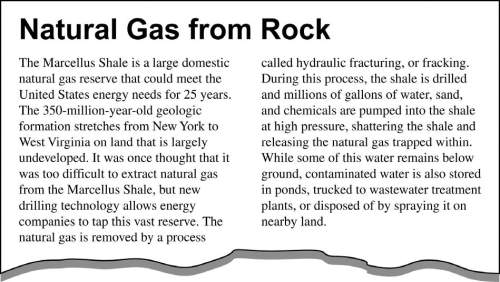
Read the (above) article from the fremont gazette and be sure to answer all three questions that follow: a. identify and describe two environmental problems associated with fracking. b. describe one economic benefit to society of using fracking to obtain natural gas from shale. c. describe which earthly sphere (or spheres) are impacted by fracking.


Answers: 1


Other questions on the subject: Physics

Physics, 22.06.2019 06:00, tylorroundy
Aball is thrown upward. at a height of 10 meters above the ground, the ball has a potential energy of 50 joules (with the potential energy equal to zero at ground level) and is moving upward with a kinetic energy of 50 joules. what is the maximum height h reached by the ball? consider air friction to be negligible. 1. h ≈ 10 m 2. h ≈ 50 m 3. h ≈ 30 m 4. h ≈ 40 m 5. h ≈ 20 m 003 10.0 points which of the two object shown below has the greatest kinetic energy? a m b 1 2 m v 2v 1. kinetic energies are the same. 2. a 3. b 4. unable to determine. 004 10.0 points tim, with mass 74.6 kg, climbs a gymnasium rope a distance of 3.1 m. the acceleration of gravity is 9.8 m/s 2 . how much potential energy does tim gain? answer in units of j. 005 10.0 points a car is moving at 64 miles per hour. the kinetic energy of that car is 5 × 105 j. how much energy does the same car have when it moves at 111 miles per hour? answer in units of j. 006 10.0 points an 102 kg man climbs up a 1 m high flight of stairs. the acceleration of gravity is 9.81 m/s 2 . w
Answers: 3

Physics, 22.06.2019 12:10, saniyawilliams1207
Energy flows from the producer level to the level. is called
Answers: 1


Physics, 22.06.2019 19:30, rprest00
Amass m = 74 kg slides on a frictionless track that has a drop, followed by a loop-the-loop with radius r = 18.4 m and finally a flat straight section at the same height as the center of the loop (18.4 m off the ground). since the mass would not make it around the loop if released from the height of the top of the loop (do you know why? ) it must be released above the top of the loop-the-loop height. (assume the mass never leaves the smooth track at any point on its path.) 1. what is the minimum speed the block must have at the top of the loop to make it around the loop-the-loop without leaving the track? 2. what height above the ground must the mass begin to make it around the loop-the-loop? 3. if the mass has just enough speed to make it around the loop without leaving the track, what will its speed be at the bottom of the loop? 4. if the mass has just enough speed to make it around the loop without leaving the track, what is its speed at the final flat level (18.4 m off the ground)? 5. now a spring with spring constant k = 15600 n/m is used on the final flat surface to stop the mass. how far does the spring compress?
Answers: 3
You know the right answer?
Read the (above) article from the fremont gazette and be sure to answer all three questions that fol...
Questions in other subjects:




Mathematics, 24.06.2021 16:30

History, 24.06.2021 16:30

Physics, 24.06.2021 16:30

Mathematics, 24.06.2021 16:30

Business, 24.06.2021 16:30

Mathematics, 24.06.2021 16:30



